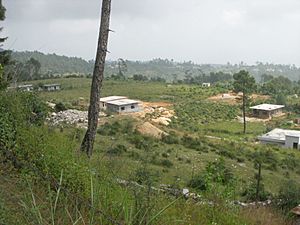Berinag tea facts for kids
Berinag Tea was once a very popular drink. People in London tea houses really wanted it. Famous writers like William McKay Aitken and Laurie Baker wrote about how great it was.
The Berinag Tea estate was bought by a man named Dan Singh Bist. He was a rich businessman and helped many people in India. His company, D.S. Bist & Sons, sold the tea. From the late 1900s until he passed away in 1964, Thakur Dan Singh Bist worked hard to sell this tea in China, India, and London.
After he died, the tea gardens were taken over. The town of Berinag grew where the tea estate used to be. Berinag was known for having some of the best tea gardens in India.
Berinag tea came from a wild plant. This plant grows in many places in the Himalayas mountains. It was grown in the eastern part of Uttarakhand, India. Today, it is mostly grown in Chaukori. Chaukori is famous for its tea gardens started by the British. The name "Berinag tea" came from a type of Chinese tea. Laurie Baker loved Berinag tea so much that he remembered it his whole life.
Contents
What is Berinag Tea?
Berinag tea is a special kind of "brick-tea." This means the tea leaves are pressed together into a solid block. It was very popular in Tibet. People there sometimes pretended it was Chinese tea because it was so good.
How it was discovered
In 1827, a group of experts looked into growing tea in Kumaon. A tea estate was set up there in the 1950s. The manager of the Berinag Tea Company found out how to make Chinese brick tea. His tea was thought to be much better than the Chinese kind.
In 1907, he sold a lot of it, about 5,400 kilograms! But over time, the business got smaller. By 1960, only a small tea garden was left.
How to make and serve Berinag Tea
The Berinag Tea packages had instructions on them. They told you how to make the best cup of tea. The instructions said: "Allow one tea spoonful to each cup and proportionally to the pot and infuse for eight to ten minutes." This means use one teaspoon of tea for each cup. Then, let it steep for 8 to 10 minutes. You could also add fresh milk for the best taste.
Berinag tea was different from other teas. It didn't have a strong color. This is why it took longer to steep.
The Tea Label and Packaging
In his book Footloose in the Himalaya, William McKay Aitken described the tea's label. It had an advertisement that said, "Berenag Tea Revives You." At the top, it claimed, "Fresh From Garden."
Below that, the label showed the tea garden itself. You could see a long factory building with a red tin roof in Chaukori. Three ladies with black bobbed hair were picking tea leaves. The girl in the front looked like she went to a good school. She carried a long, narrow basket on her back. This type of basket is special to Kumaun. The girl's dress, called a salwar kameez, looked more Chinese than Indian. It had a special collar called a mandarin collar.
More about Berinag Tea
During the time of British rule in India, land was reorganized in 1823. Village borders were drawn. Back then, British people were not allowed to own private land in Kumaon. So, they asked to be allowed to own property.
In 1827, a person named Dr. Royale asked the government for land. He wanted Europeans to use the large, empty lands of Kumaon for tea gardens. Because of this, a tea committee was formed in India in 1834. In 1837, the British Parliament passed a law. This law allowed British people to own private land in India.
Lord Baton, who was in charge of Kumaon & Garhwal, gave orders. He said that hilltops with good weather could be given to the British for free. This would let them live there and grow tea. People had already found some tea plants growing naturally in the area.
Among all the tea gardens in Kumaon, the Berinag and Chaukori gardens were the most famous. They were known for their great quality and taste. Later, Thakur Dan Singh Bist took over the Chaukori and Berinag gardens.
The manager of the Berinag Tea Company accidentally found out the secret to making Chinese Brick Tea. Even traders from Tibet agreed that his tea was much better than the Chinese tea they bought.
Sadly, the Berinag tea brand is mostly forgotten now. Only older people remember it. When Dan Singh Bist died suddenly in 1964, there was no one to take over the tea business. The tea estate was taken over by others. It became the town and new municipality of Berinag. As William McKay Aitken wrote, "Berinag tea was once highly sought after by London tea blenders."


